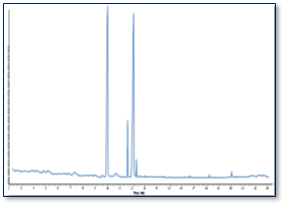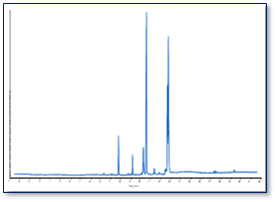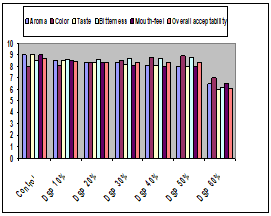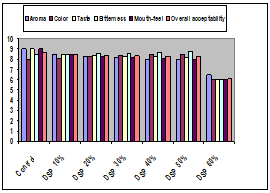


Utilization From Date Seeds as A By-Product Low-Cost to Prepare Beverage Cappuccino and The Latte Less Caffeine
Eman Hassan Ahmed Algarni
Food Science and Nutrition Department, College Science, Taif University, Saudi Arabia.
Abstract
This article provided information on the nutritional, mineral content, antioxidant activity and quantity, and functional constituents of dates (Phoenix dactylifera L.) seeds powder. Moreover, the date seeds as a low-cost by-product were used to prepare cappuccino and the latte-less caffeine. The results observed that the date seeds powder was a source of dietary fibers fraction, minerals such as potassium, sodium, and calcium, and a high quantity of total phenol and flavonoid compounds and also, a natural antioxidant. The HPLC analysis of flavonoid compounds fractionated from the date seeds powder found apigenin, kaempferol, quercetin, luteolin, and rutin as major flavonoid compounds. The phenol content was particularly enriched in p-coumaric, gallic, resorcinol, pyrogallol, ferulic, and chlorogenic acids. The sensory evaluation for the beverages cappuccino and latte were prepared with date seeds powder at a different level from date seeds powder in Nescafe as a control sample. The results reported that the beverage cappuccino and latte give the best acceptability up to 50% when adding date seeds. From the results, it could be concluded that the date seeds as a by-product will be used for human food and the beverage may be due to the date seeds contain high amounts of minerals content, dietary fibers, natural antioxidants, and importantly, are free from caffeine. It could be recommended that the prepared beverage cappuccino and the latte with up to 50% date seeds powder had acceptability through the sensory evaluation.
Keywords:Date seeds powder, beverage cappuccino and the latte, less caffeine
From ancient times to now, the use of medicinal plants for the treatment and prevention of diseases has always been interested by human societies in all countries of the world (Kiani et al., 2018; Bounar et al., 2018). Currently, a broad spectrum of medicinal herbs is existing (Sargia et al., 2018; Kianitalaei et al., 2019). Date seeds (phoenix dactylifera L.) are obtained simultaneously with more dates' products and have weighted 10-13%, dry weight of the date fruit (Tang, et al., 2013). Date seed has been chemically estimated which points out the considerable quantity of crude oil, protein, and high amounts of the dietary fibers (9.0, 5.1, and 73%, respectively) (Al-Farsi and Lee, 2008a). Date seeds had lower soluble fibers than the major insoluble fraction in date seed. In addition to potassium (0.5 %) that has the greatest concentration, other minerals were found in medium amounts. Furthermore, some date seeds had contained traces of elements like aluminum, lead, cadmium, chloride, and sulfur (Al-Farsi et al., 2005 a,b). Phenolic compounds and natural antioxidants have high amounts in date seeds (Al-Farsi and Lee, 2008b). Besbes et al. (2004) found the highest amounts of total sterols and β-sitosterol for several date seed cultivars, also oestrone is water-soluble as galactomannan.
Date seeds possess good nutritional properties. However, the variety and quality of fruit depend on origin, fertilizer application, and harvesting time. Compositional analysis revealed that seed comprises of 10.20% moisture, 1.18% ash, 10.36% protein, oil, and 72.59%carbohydrate. Three major components i.e carbohydrate, protein, and oil are important for seed germination. It is a rich source of dietary fiber. Coarsely milled date seeds contained about 80% of dietary fiber while finely milled seeds contained 71% of dietary fiber. It is helpful for certain disorders such as obesity, diabetes, cholesterol, and intestinal complaints (Al-Farsi et al., 2007).
Minerals present in date seeds are potassium, magnesium, calcium, phosphorus, sodium, and iron. Potassium is present in large quantity and its concentration is 3790 mg/kg. Potassium plays an important role as an electrolyte in the body which closely related to sodium metabolism. It also helps to regulate the heartbeat. Nervous disorders and insomnia are major problems associated with its deficiency (Habib and Ibrahim, 2009).
Date seeds contain numerous bioactive moieties with therapeutic effects against various ailments (Geetha and Geetha 2014). Phytochemicals present in date seeds include flavonoids, phenolic acids, sterols, and tocopherols. Major flavonoid is hesperidin (17.27 mg/100g) that has health benefits like lowering cancer, preventing atherosclerosis, and inhibiting loss of bone while phenolic acids include protocatechuic, hydroxybenzoic, coumaric, ferulic and caffeic acids (Al-Farsi and Lee, 2008b).
Abdillah and Andriani (2012) introduced Turkish caffeine-free coffee with mixing flavor to give healthier coffee low in price, and it was made from date seed to make it tasty. As another option, it was utilized in preparing ‘Cappuccino Choco Float’ where it is mixed with chocolate. For this reason, the date seeds had contained high amounts of minerals and natural antioxidants to satisfying daily recommended dietary needs.
The aim of this research was to estimate the nutrient content, phytochemical function, and emulsification properties of date seeds powder. Moreover, the date seeds powder was substituted Nescafe to produce cappuccino and latte drinks, and sensory properties were determined.
Materials
Dates palm fruits (Phoenix dactylifera) of variety Sukkari was purchased from the Kingdom of Saudi Arabia. The dates in “Tamr” stage (maturity stage) were obtained from the farmers and the samples were collected during 2019. Nescafe, liquid milk, and butterfat cream were obtained from the local market in the Kingdom of Saudi Arabia.
Methods
Preparation of date seeds powder
The seeds were soaked in water for 72 hours to increase their feeding value (Barreveld, 1993), washed to get rid of any adhering flesh, air-dried for one day, then dried in a medium heat oven at 50°C for one hour and grounded into a coarse powder using a hammer mill. Then again ground into a fine powder using a commercial home milling machine to produce fine date seeds powder which was then kept in an airtight container (Barreveld, 1993).
Nutrient content of date seeds power:
The chemical composition such as protein content, ash content, total lipids, and total carbohydrates were determined in different varieties of palm date fruits according to AOAC (2012). Moreover, total dietary fiber was determined in the raw materials and their blends according to the methods described by Prosky (1988). Also, soluble and insoluble dietary fibers were determined in the raw materials and their blends according to Lee and Prosky (1995).
Minerals content such as Sodium (Na), Potassium (K), Manganese (Mn), Zinc (Zn), Iron (Fe), Copper (Cu), and Calcium (Ca) were determined in date seeds powder according to AOAC (2012).
Phytochemical characteristics of date seeds power
The total phenol content of the extracts was determined using Folin–Ciocalteau reagent according to Xu and Chang (2007). The total phenolic content was calculated using milligrams gallic acid equivalents per gram of dry weight (GAE mg/g of dry weight).
The total flavonoid content was determined by the method of Eghdami and Sadeghi (2010). The flavonoids content is expressed in milligrams of quercetin equivalent per gram dry weight (mg QE /g of dry weight).
2,2-Diphenyl-1-picrylhydrazyl (DPPH) antioxidant assay was performed based on the modified method of Liu et al. (2008). The antioxidant activity of the sample was determined based on the equations: % DPPH Scavenging = [(𝐴𝐶𝑜𝑛𝑡𝑟𝑜𝑙−𝐴𝑆𝑎𝑚𝑝𝑙𝑒) 𝐶𝑜𝑛𝑡𝑟𝑜𝑙] × 100%
Where, a control is the absorbance of DPPH solution without addition of sample and A sample is the absorbance of DPPH solution by the addition of sample.
Ferric reducing antioxidant power (FRAP) assay evaluated the capacity of a substance to reduce Fe3+ in the Fe3+-TPTZ complex (ferric-2,4,6-tripyridyl-s-Triazine) into Fe2+-TPTZ. The reducing antioxidant power of samples was estimated by modifying the method of Chen et al. (2014). The results were expressed as mg ascorbic acid equivalents per g of fresh sample weight (mg ascorbic acid equivalent/g).
2,2’-Azinobis-(3-ethylbenzo-thiazoline-6-sulfonic acid) (ABTS) Radical Scavenging Activity was measured by the method of Severo et al. (2011). The results were expressed as mg ascorbic acid equivalent per gram of sample (mg ascorbic acid equivalent/g).
Determination of functional and emulsification properties of date seed powder
Water absorption capacity (WAC), and fat absorption capacity (FAC) of date seeds powder was estimated by the methods described by Chantaro et al. (2008) and Vazquez-Ovando et al. (2009).
Emulsification capacity (EC) of the sample was determined by the method described by Beuchat et al. (1975) and also emulsifying activity and emulsion stability were described by Vázquez-Ovando et al. (2009).
Quantitative determination of flavonoids by HPLC:
HPLC analyses were performed with Dionex Ultimate 3000 liquid chromatography (Germany) with four solvent delivery system quaternary pump (LPG 3400 SD) and Chromeleon 6.8 system manager as a data processor. The separation was achieved by a reversed-phase Acclaim TM 120 C18 column (5 μm particle sizes, 4.6 x 250 mm) according to Zuo et al. (2002). The quantification of the sample was done by the measurement of the integrated peak area and the content was calculated using the calibration curve by plotting peak area against the concentration of the respective standard sample.
Quantitative determination of phenolic compounds by HPLC:
Phenolic compounds were determined by HPLC according to the method of Goupy et al. (1999). The phenolic acid standard was dissolved in a mobile phase and injected into HPLC. Retention time and peak area were used to calculation of phenolic compounds concentration by the data of Hewllet Packared software.
Preparation of cappuccino and latte formulae
Cappuccino and latte formulae were prepared from Nescafe substituted with date seeds powder at levels 10, 20, 30, 40, 50, and 60%, respectively, to give six formulae to compare with Nescafe as a control.
Preparation of a hot cappuccino drink
The cappuccino was prepared using the powdered milk 30 ml, Nescafe 15 ml with different levels of date seeds powder, and butterfat cream 60 ml. These ingredients were mixed and then water was added and stirred slowly so that the cream did not mix with water and heat to get coffee-less cappuccino using different levels of date seeds powder.
Preparation of a hot latte drink
The latte was prepared using 125 ml Nescafe with different levels of date seeds powder, 375 ml water, and 375 ml liquid milk. These ingredients were mixed with water in a bowl and over the heat and also the milk was heat in another bowl. Equal amounts of the different formulae and milk were poured in the serving cups to get coffee-less latte drink using different levels of date seeds powder.
Sensory characteristics of syrup dates palm:
The sensory properties of date cappuccino and latte with different concentrations of date seeds powder were assessed to determine the acceptability of the product. Cappuccino and latte were presented in cups with different numbers to ten panelists of staff members at the Food Science and Nutrition Department, College Science, Taif University, Saudi Arabia, who were asked to rate each sensory attribute. Date cappuccino and latte were evaluated for aroma, color, taste, bitterness, mouth-feel, and overall acceptability according to Hoda and Jood (2005).
Statistical analysis
The data were subjected to multivariate statistical analysis by mean comparisons using the statistical software SAS 9.2 (SAS Institute, 2011).
Nutrient content date seed powder
Nutritional content such as chemical composition and dietary fiber fraction were determined in date powder and the results are reported in Table (1). From the results, it could be indicated that the date seeds powder significantly contained the highest amounts in total carbohydrates, and crude fiber was 52.87 and 27.15%, respectively. Furthermore, the total protein, fat content, and ash were 7.73, 7.90, and 4.35%, respectively. These results assured that the date seeds powder was a rich source in total dietary fiber, insoluble, and soluble dietary fibers (67.56, 46.38, and 21.18%, respectively). These results are in agreement with Rashmika et al. (2018) who found that date seeds mainly reduce the agro-waste and they contain protein (2.3–6.4%), fat (5.0–13.2), dietary fiber (22.5–80.2%) and minerals. Cocoa powder was used for the flavor of the spread and they reduce LDL cholesterol, blood clots, and high blood pressure.
In the production of a new generation, date kernels play an imperative role in plant generation and growth. Generally, a kernel contains carbohydrates, protein as well as fats in the form of wax or oil. Amongst these 3 constituents, fat possesses the greatest significance for kernel sprouting as the fat can provide a double amount of energy in contrast to starch and proteins (Baud and Lepiniec, 2010).
Table 1: Nutrient content of date seed powder on a dry weight basis
|
Nutrient content |
Date seeds powder % |
|
Protein |
7.73±0.95d |
|
Fat |
7.90±0.71d |
|
Crude fiber |
27.15±1,86c |
|
Ash |
4.35±0.27e |
|
Total carbohydrates |
52.87±3.67b |
|
Total dietary fiber |
67.56±4.35a |
|
Insoluble dietary fiber |
46.38±2.91b |
|
Soluble dietary fiber |
21.18±1.24c |
The findings are shown as the mean ± standard deviation (n = 3). Means within the same row having various superscript letters are significantly different at p ≤ 0.05
Minerals content of date seed powder
Minerals content was determined in date seeds powder and the findings are recorded in Table (2). The outcomes observed that date seeds powder had the highest potassium, sodium, and calcium (133.62, 114.2, and 25.02 mg/100g, respectively). Iron, manganese, zinc, and copper were the lowest amounts in date seeds powder. These results confirmed with Biglari (2009) who found that the date fruits had high amounts of some minerals like sodium, potassium, magnesium, calcium, and iron, also, medium amounts of the other minerals are present in the date fruits. Moreover, date seeds are reported to have high amounts of many minerals like micro and macro-elements (Abdillah and Andriani, 2012 and Abdul Afiq et al., 2013). Potassium, phosphorus, magnesium, calcium, and sodium are in higher concentrations in date seeds (Besbes et al., 2004). Iron and then manganese, zinc, and copper are found in lower concentrations between the microelements (Sawaya et al., 1984).
Phytochemical and technological properties from date seeds power
Phytochemicals analysis and technological properties were determined in date seeds powder and the findings are tabulated in Table (3). The outcomes observed that the total phenol content and total flavonoids compounds were 13.20 mg/g gallic acids equivalent and 5.15 mg/g quercetin equivalent. Moreover, antioxidant activity, DPPH radical scavenging activity, Ferric reducing antioxidant power (FRAP) activity, Radical Scavenging Activity (ABTS were found 57.25%, 0.04, 1.92 mg ascorbic acid equivalent/g, respectively). More of these phytochemicals have antioxidant capacities that inhibited reactive oxygen species (ROS) production, protected antioxidant enzymes, and reversed hepatotoxicity (Deng et al., 2012). Phenolic compounds are the greatest compounds with natural antioxidant characteristics and antimicrobial activity. Moreover, in all the extracts of fruits, vegetables, and seeds have been estimated to lower lipid oxidation and/or microbial spoilage in meat products (Kryževičūté et al., 2017). In addition, date pit powder had the highest values of radical scavenging capacity, chelating activity, lowering power, and suppression of lipid peroxidation (Martín-Sánchez et al., 2014).
Table 2: Minerals content of date seed powder on a dry weight basis (mg/100)
|
Minerals content |
Date seeds powder (mg/100) |
|
Sodium (Na) |
114.2±7.38b |
|
Potassium (K) |
133.62±20.25a |
|
Manganese (Mn) |
0.27±0.01e |
|
Zinc (Zn) |
0.25±0.01e |
|
Iron (Fe) |
1.39±0.04d |
|
Copper (Cu) |
0.14±0.00f |
|
Calcium (Ca) |
25.02±1.78c |
The findings are shown as the mean ± standard deviation (n = 3). Means within the same row having various superscript letters are significantly different at p ≤ 0.05.
Concerning the same table illustrated that the technological properties such as WAC (Water absorption capacity), FAC (Fat absorption capacity), EC (Emulsification capacity), EA (Emulsification activity), ES (Emulsification solubility) were 0.48 ml/g, 0.87 ml/g, 79.38 ml/g, 55.67 ml/100ml emulsions, 69.17%, respectively. Water absorption capacitymay assist to make a pleasant texture and decrease syneresis and dehydration through storage, whilst a great FAC may supply a non-greasy sensation, and stabilize fatty products (Akasha et al., 2016). Meanwhile, date seeds powder could be the best emulsifying factor, with emulsion stability of 100%. According to Akasha et al. (2016), the seed proteins are connected with polysaccharides and impact their functional characteristics and elevate the capacity of emulsifier. The emulsifying activity shows its capacity to adsorb biliary acids, shortening their intestinal absorption, and thus lowering cholesterol. Date pit powder gives the same EA found in chia fiber (Vázquez-Ovando et al., 2009).
Quantitative and fractionation flavonoids compounds from date seeds powder using HPLC
Flavonoids compounds were fractionated and quantities from date seeds powder extract were determined using HPLC and the findings are reported in Table (4) and Figure (1). The HPLC analysis of flavonoids compounds fractionated from the methanol extract to major flavonoids apigenin, keampferol, quercetin, luteolin and rutin (33.55, 26.40, 13.57, 13.43 and 10,03 mg/100g dry weight, respectively). The narengin was the minor flavonoid compound. Date seeds contained p-coumaric acid and it was reported in one study that feeding p-coumaric acid antioxidant enzyme increases genes expression in cardiac tissue of rats. Phenolic compounds present in date seeds were procyanidins, anthocyanins, glycosides, and flavonoids (Allaith, 2008).
These act as antioxidants during different techniques, involving hydrogen donating reactions, metal chelating, and safeguard of antioxidant defenses (Pereira et al., 2013). Natural antioxidant compounds can delay the lipid profile oxidation or other molecules by preventing the diffusion of oxidative chain reaction (Biglari, 2009). Date seeds powder is a rich source of different polyphenols that may participate in the mentioned activity.
Table 3: Phytochemical and technological properties of date seeds power
|
Phytochemical |
Date seeds powder |
Technological properties |
Date seeds powder |
|
Total phenol |
13.20±1.25b |
WAC ml/g |
0.48±0.02e |
|
Total Flavonoids |
5.15 ±0.82c |
FAC ml/g |
0.87±0.03d |
|
DPPH |
57.25 ±3.49a |
E.C. mg oil/g |
79.38±6.25a |
|
FRAP |
0.04±0.00e |
E. A. ml/100ml emulsion |
55.67±4.32c |
|
ABTS |
1.92±0.03d |
E.S % |
69.17±5.61b |
The findings are shown as the mean ± standard deviation (n = 3). Means within the same row having various superscript letters are significantly different at p ≤ 0.05.
Total phenol as mg/g gallic acids equivalent, Total Flavonoids as mg/g quercetin equivalent, DPPH radical scavenging activity (%), Ferric reducing antioxidant power (FRAP) activity as mg ascorbic acid equivalent/g, Radical Scavenging Activity (ABTS) as mg ascorbic acid equivalent/g., WAC (Water absorption capacity), FAC (Fat absorption capacity), EC (Emulsification capacity), EA (Emulsification activity), ES (Emulsification solubility).
Table 4: Flavonoid compounds (mg/100g) in methanol extract from date seeds powder
|
Flavonoids compounds |
Rt (min) |
Quantification (mg/100 g dw) |
% |
|
Apigenin |
9.85 |
25.23±0.25a |
33.55 |
|
Luteolin |
11.74 |
10.1±0.12c |
13.43 |
|
Kaempferol |
12.1 |
19.85±0.18b |
26.40 |
|
Rutin |
12.6 |
7.54±0.08d |
10.03 |
|
Quercetin |
13..3 |
10.2±0.11c |
13.57 |
|
Narengin |
15.7 |
2.27 ± 0.09e |
3.02 |
The findings are shown as the mean ± standard deviation (n = 3). Means within the same row having various superscript letters are significantly different at p ≤ 0.05.

Figure 1: HPLC chromatograms for flavonoid compounds (mg/100g) in methanol extract from date seeds powder.
Quantitative and fractionation of total phenolic acids from date seeds powder using HPLC
The identification of total phenolic acid and quantities from date seeds powder extract were determined using HPLC and the findings are reported in Table (5) and Figure (2). HPLC analysis allowed concluding that methanol extract was particularly enriched in p-coumaric, gallic, resorcinol, pyrogallol, ferulic, and chlorogenic acids which accounted for approximately 24.28, 19.39, 15.82, 13.23, 13.20, and 8.65mg/100g dry weight of the total quantified phenolic acids for date seeds powder. Moreover, the extract contained lesser quantities of other phenolic acids including catechol and ellagic acids (3.05 and 2.38 mg/100g dry weight, respectively). Mansouri et al., (2005) fractionated the phenolic compounds for seven cultivars of date and the results showed that the major compounds were p-coumaric, ferulic, and sinapic acids.
The natural antioxidant activity may be caused by different phenolic compounds. These compounds consist of an aromatic benzene ring linked to one or more hydroxyl groups. Moreover, dietary natural antioxidants were present to safeguard different diseases (Vanin et al., 2014).
Table 5: Phenolic content (mg/100g) in methanol extract of date seeds powder.
|
phenolic acids |
Rt (min) |
Quantification (mg/100 g dw) |
% |
|
Ppyrogallol |
6.8 |
8.53 ± 0.50c |
13.23 |
|
Chlorogenic |
8.2 |
5.58 ± 0.27d |
8.65 |
|
Ferulic acid |
14.8 |
8.51 ± 0.14c |
13.20 |
|
p-Coumaric |
16.4 |
15.65 ± 1.77a |
24.28 |
|
Ellagic acid |
17.8 |
1.54±0.18e |
2.38 |
|
Catechol |
19.1 |
1.96±0.02e |
3.05 |
|
Resorcinol |
20.9 |
10.2±1.43b |
15.82 |
|
Gallic acid |
23.2 |
12 .5±0.97ab |
19.39 |
The findings are shown as the mean ± standard deviation (n = 3). Means within the same row having various superscript letters are significantly different at p ≤ 0.05.

Figure 2: HPLC chromatograms for phenolic content (mg/100g) in methanol extract of date seeds powder.
Sensory evaluation of cappuccino and latte with date seed powder
The sensory evaluation for the cappuccino and latte were prepared with date seeds powder at different levels in comparison to Nescafe and the evaluations are presented in Figures 3 and 4. From the results it could be noticed that there were no significant differences in the aroma, color, taste, bitterness, flavor, and overall acceptability until adding date seeds powder at a level of 50% of beverage compared to Nescafe as a control sample. Beverage cappuccino and latte until added 50% date seeds powder are the best in color, and bitterness; in addition, it has slightly decreased or near Nescafe control in taste, flavor, and overall quality. Moreover, cappuccino and latte with date seeds powder may had been made better by changing production methods and/or by an increase of flavor to give the best taste and great nutritional and health safety. Also, it could introduce the coffee from palm date seeds to people sensitive to caffeine and enjoy the aroma of the coffee without the reverse impacts (El Sheikh et al., 2014). After drying, the date seeds powder was utilized to get extra flavor and aroma. The seed powder was mixed with water, stirred occasionally until foam occurred on the top, and let boil slowly for a few minutes to get caffeine-less coffee (Sekeroglu et al., 2012).
Date seed powder is utilized for cappuccino choco float. Firstly, date seeds powder was mixed with 1) chocolate powder, 2) milk powder, 3) creamer, 4) granulated sugar, and 5) shaved ice. After blending all together, chocolate ice cream was put on it (Bouaziz et al., 2010). Date seeds are by-products that could be an excellent source of fiber because they contain high proportions of fiber (Al-Shahib and Marshall, 2003). It was concluded that date palm seeds contain ion elements inside the range of dietary intake levels in humans (Sofi et al., 2007). Date seeds are rich in oil, proteins, minerals, and fiber (Gonzalez-Rios et al., 2007). The date pits from various cultivars contained a significant amount of important minerals (Jolad et al., 2004). Palm seeds have useful influences on male reproductive activity and increase fertility in male adult rats (Bawazir and Saddiq, 2010). Date seeds powder is used for cappuccino and latte at different levels and can be made better by changing production methods and by mixing with flavor and spices to give a better taste and greater nutritional health.

Figure 3: Sensory evaluation of cappuccino with date seed powder (DSP)

Figure 4: Sensory evaluation of latte with date seed powder (DSP)
Date seeds powder contained rich amounts of dietary fiber, total carbohydrates, minerals content, phytochemistry, the antioxidant activity, and major phenolic and flavonoid compounds. From these nutrition factors, date seeds powder could be used until 50% substituted to prepare cappuccino and the latte beverage.
REFERENCES
 This work is licensed under a Creative Commons Attribution 4.0 International License.
This work is licensed under a Creative Commons Attribution 4.0 International License.